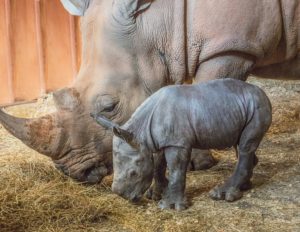 The North Carolina Zoo is excited to announce the birth of a third southern white rhino in just under two years. The female calf was born on Sunday, Jan. 5, to mother Kit and father Stormy. The calf weighed approximately 100 pounds and will be named at a later time.
The North Carolina Zoo is excited to announce the birth of a third southern white rhino in just under two years. The female calf was born on Sunday, Jan. 5, to mother Kit and father Stormy. The calf weighed approximately 100 pounds and will be named at a later time.
This birth marks another significant achievement for the zookeepers and the veterinarian team who work with the Zoo’s rhino herd every day.
“This is a great moment and testament to the dedication of our Zoo staff,” Zoo Director Pat Simmons said. “These successful births are because of a lot of hard work and collaboration among our entire animal care staff.”
Jade Tuttle, zookeeper for the Zoo and a board member of International Rhino Keepers Association, said the calf and her mother are doing well.
“Grassland keepers are thrilled at yet another addition to our herd!” Tuttle said. “It’s a great gift to usher in the New Year and the new decade here at the North Carolina Zoo!”
The Zoo has been home to rhinos since 1976 as part of the Association of Zoos and Aquariums (AZA) Species Survival Plan (SSP). However, the Zoo waited for more than 40 years for a healthy rhino calf.
The Zoo’s 40-acre Watani Grasslands expansion – completed in 2008 – was created specifically for a breeding rhino herd, making these multiple births a dream come true.
Zookeepers report the new calf is healthy and nursing. They expect her to gain 100 pounds a month in the first year. She could weigh 3,500 to 5,500 pounds when fully grown.
“Congratulations to the North Carolina Zoo on the successful birth of a third Southern white rhino in just two years,” said Susi H. Hamilton, secretary of the N.C. Dept. of Natural and Cultural Resources. “I’m proud of the Zoo’s continuing commitment to saving this and other threatened species at home and around the world.”
Southern white rhinos were hunted to near extinction by the beginning of the 20th century for their horns, which some erroneously believe provide medicinal benefits. Rhino horn is constructed from keratin, which is the same material that makes up human fingernails and hair.
Today, populations in the wild still face significant threats from poaching and habitat loss. In addition to their work with the rhinos at the North Carolina Zoo, staff work on projects in several countries in Southern Africa to protect wild rhinos from poaching and save the species from extinction.
The Zoo’s herd now consists of nine rhinos: male Stormy; females Linda, Kit, Natalie, Abby, and Olivia; and calves Nandi and Bonnie and the new female calf just born.
The second-largest land mammal after elephants, rhinos are pregnant from 16 to 18 months (elephants are pregnant for approximately 24 months). A rhino will only give birth every two to five years. At full maturity, a southern white rhino will have two horns, grow 12 to 13 feet long and up to 6 feet from hoof to shoulder, and weigh 4,000 to 5,000 pounds. They can live 40 to 50 years and run at impressive speeds of up to 30 miles per hour.


